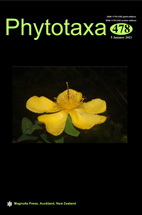Abstract
Styrax hwangiae, a new species with a narrow geographic distribution in limestone areas of Jingxi and Longzhou counties, Guangxi, China, is here described. The new species is similar to S. rugosus in habit, rugose leaves, shape of flowers and fruits, and to S. tonkinensis in habit and leaf shape, but it differs from S. rugosus by its longer petiole, paniculate or racemose inflorescence with more flowers, calyx abaxially tissue extend outward into many spires covered by many trichomes, flexuous longer filaments, and larger fruits with thicker pericarp, and from S. tonkinensis in its thickly leathery and rugose leaf blades, larger calyx and shorter peduncles. Colour plates of S. hwangiae, a distribution map and a table comparing the morphology of the three species are provided.

